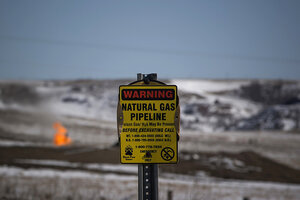Obama targets methane. What is it? Why does it matter?
To combat climate change, the Obama administration is targeting methane – a greenhouse gas that's less prevalent but more potent than carbon dioxide. The oil and gas industry is already trying to stop leaks, though, and argues more regulation would be cumbersome.

A warning sign for a natural gas pipeline is seen as natural gas flares at an oil pump site outside of Williston, North Dakota.
Shannon Stapleton/Reuters/File
Washington
Add methane reduction to President Obama’s expanding portfolio of climate change initiatives.
The White House announced Wednesday a plan to slash methane emissions from the oil and gas industry by 40 to 45 percent over the next decade. It expands the scope of the administration’s climate policies, which so far have largely focused on carbon emissions and other pollutants from coal plants and your car’s tailpipe.
So why the emphasis on methane now? For starters, the US has seen a recent boom in the production of natural gas, which is essentially methane. Because of its relative abundance, and because it’s cleaner burning than coal, power plants across the country have been switching to it as a preferred fuel. Its profile is expanding in the transportation sector as well.
All the new gas production and consumption increases the chance of methane leaking or otherwise escaping. And while methane doesn’t stay in the atmosphere as long as carbon dioxide, it is much more effective at trapping heat while it’s there. Obama's policies would stanch leaks at wells, pipelines, and valves to stop methane from escaping throughout its life cycle.
The rules the White House proposed Wednesday are also a way for the White House to meet a goal it set with the world’s No. 1 greenhouse gas emitter: China. At a meeting in Beijing in November, Obama agreed to cut US greenhouse emissions 26 to 28 percent below 2005 levels by 2025.
"I think that [methane reductions] will make a significant contribution to our overall effort to meet the goal the president laid out in Beijing," White House energy and climate adviser Dan Utech told reporters in a call Wednesday.
But like many of Obama’s climate and energy policies, it’s unclear how those methane targets will be achieved – especially given the fact that Obama leaves office in two years, and his time frame for methane cuts is much longer. Beyond that, the methane-cutting regulations EPA releases this summer may be too modest to make much of a dent, analysts say, since they would only apply to new and modified oil and gas operations, and not to existing ones.
Climate-warming methane escapes into the atmosphere during production and transportation of natural gas and oil, undercutting one of the biggest arguments in favor of natural gas – that it’s a relatively clean, lower-emission fuel. Switching from coal to natural gas is only a net positive for the environment if reduced carbon emissions outweigh new emissions of methane.
"It is the largest opportunity to deal with climate pollution that this administration has not already seized," David Doniger, director of the climate and clean air program at the Natural Resources Defense Council, an environmental group, told The Guardian.
The oil and gas industry is pushing back against the methane cuts, saying it’s already made progress towards slashing wasteful emissions for economic reasons alone. Energy firms also say they have a natural incentive to reduce natural gas leaks because the methane that escapes is a commodity that has value, as opposed to a waste byproduct.
“Another layer of burdensome requirements could actually slow down industry progress to reduce methane emissions,” Jack Gerard, president of the American Petroleum Institute, an industry group, said in a statement.
In 2012, methane emissions accounted for nearly 10 percent of US greenhouse gas emissions, according to the White House, of which nearly 30 percent came from producing and distributing oil and natural gas. Emissions from the energy sector have fallen 16 percent since 1990, but are projected to rise more than 25 percent by 2025 without additional steps to lower them, the White House says.
For industry, more regulations are unwelcome when US oil and gas companies are already operating in a difficult market. Crude has collapsed 50 percent in the last six months, falling from over $100 a barrel in June to below $50 a barrel this month. Oil and gas-producing states like North Dakota and Texas may be reluctant to ramp up regulation amid falling oil and natural gas prices.
Environmentalists and climate activists have argued that excess methane emissions – which have major climate-altering consequences – negate the progress the US has made by shifting from coal to natural gas. And environmentalists say methane emissions are higher than industry and the EPA suggest.
The amount of methane pollution from the oil and gas sector is equivalent to the carbon pollution from 180 coal-fired power plants, according to Jeremy Symons, senior director of climate policy at the Environmental Defense Fund, an environmental group.
“This is an enormous amount of wasted energy that is enough to heat six million homes,” Symons said in a call with reporters. “It also contributes significantly to climate change because methane is such a potent greenhouse gas.”
Green groups praised Obama’s initial action, but pushed for stronger reductions in the future – and for Obama to reduce emissions from existing sources.
EPA said it was training its sights – at least for now – on future sources of emissions.
"We're going to focus our rulemaking on the emissions sources that make the most sense to address now: new emissions sources in areas of this industry where new investment and growth are occurring, and where emissions are increasing as a result," EPA air chief Janet McCabe said on a call with reporters Wednesday.

